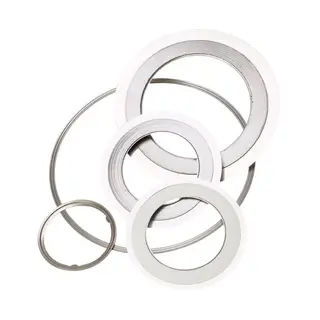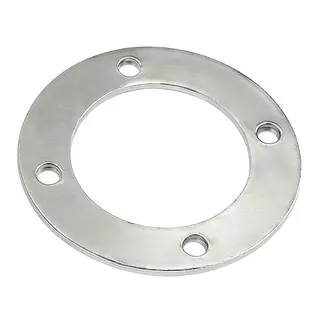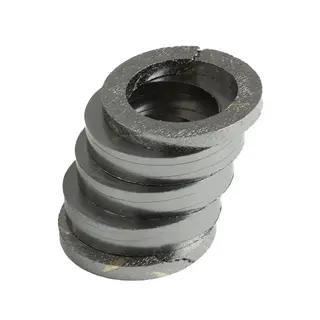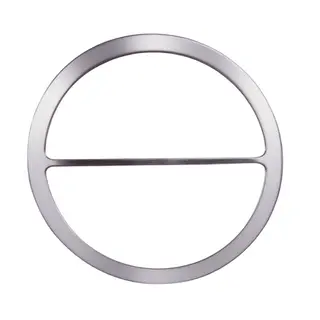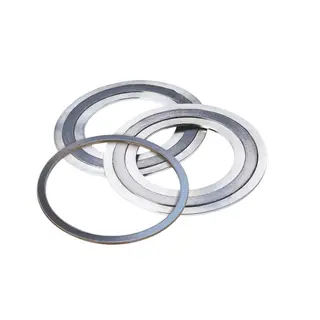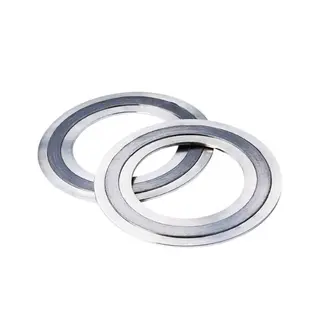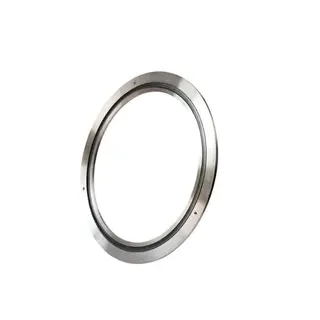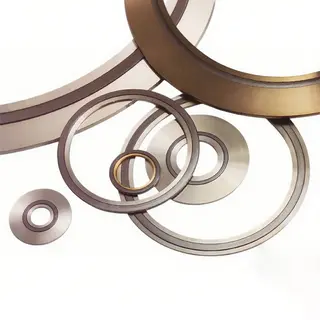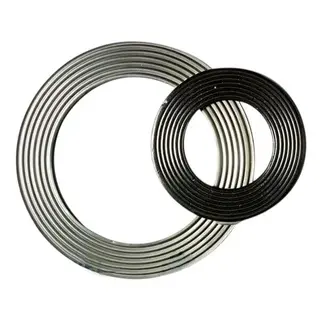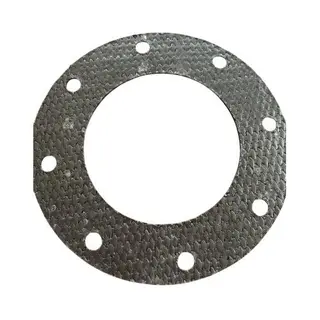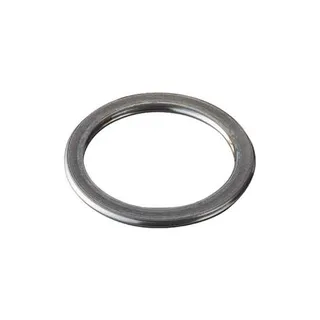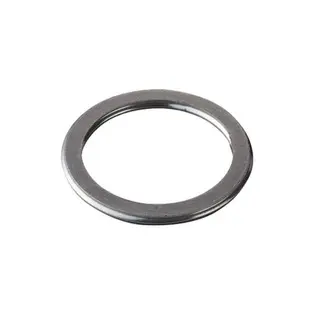Graphite gaskets are categorized based on their construction and application requirements. Here are the common types:
1. Solid Graphite Gaskets: Made entirely from flexible graphite sheets, Suitable for applications requiring high chemical resistance and thermal stability.
2. Metal-Reinforced Graphite Gaskets: Incorporating metal components to enhance mechanical strength, including
Hooked Carbon Steel Reinforced: Carbon steel sheet sandwiched between graphite layers.
Stainless Steel Reinforced: Stainless steel (304 or 316L) sheet adhered to graphite layers.
3. Composite Graphite Gaskets
Combine graphite with other materials to improve performance.
Common forms:
Basic Type: Simple graphite gasket without additional reinforcement.
Inner-Edge Wrapped: Graphite gasket with an inner edge wrapped in stainless steel.
Outer-Edge Wrapped: Graphite gasket with an outer edge wrapped in stainless steel.
Fully Wrapped: Graphite gasket with both inner and outer edges wrapped in stainless steel.
4. Specialty Graphite Gaskets
Designed for specific applications or environments.
Examples:
High-Temperature Applications: Graphite gaskets suitable for extreme temperatures.
Chemical-Resistant Applications: Graphite gaskets with enhanced resistance to specific chemicals.
In the quest for environmental sustainability and regulatory compliance, industries are increasingly adopting stringent standards to minimize fugitive emissions. These standards not only help in reducing harmful pollutants but also enhance safety and operational efficiency. Here are some key standards that play a crucial role in achieving low emission goals:
ISO 15848 standardizes the measurement, testing, and evaluation procedures for industrial valve fugitive emissions. This standard is divided into two parts. ISO 15848-1 defines the test procedures for valve type testing, and ISO 15848-2 specifies the requirements for the manufacturing of valve products.
The German fugitive emission control law TA-LUFT VDI2440 defines the leakage rate, testing, and testing methods.
According to TA-LUFT and VDI 2440, the flange connection must meet the test pressure of 1 bar under the condition that the leakage rate is less than 10−4 mbar × l/(s × m). VDI 2200 specifies the selection, calculation, design, installation, and testing process of the flange connection. It also allows reference to VDI 2440 for the leakage rate. VDI 2200 also stipulates the burst pressure test to avoid the risk of flange breakage and sudden leakage.
The Clean Air Act stipulates that the maximum allowable leakage rate for valves, pumps, and agitators in the United States must comply with the EPA Method21 (blower method) for leakage testing, and the testing method must be consistent.
API 622 is the second edition of the international performance test for disk root materials, which includes temperature, pressure, thermal cycles, and mechanical cycles. API 622 specifies 1510 mechanical cycles and 5 thermal cycles, from room temperature to 260°C (500°F), pressure from 0 to 600 psi (0-41bar), for high-temperature testing. Under carbon equivalent testing, the allowable leakage rate is 100 ppm.
The first edition of the API 624 standard for the type test of the fugitive emission of the valve with a graphite seal includes the up and down motion and rotation of the valve, with a maximum diameter of 24 inches. The test requires the temperature to rise to 260°C (500°F) and perform 310 mechanical cycles and 3 thermal cycles, with the maximum allowable leakage rate being 100 ppm. The valve to be tested must first be tested according to API 622, and the temperature range is from -29°C to 538°C (-20°F to 1000°F).
Excellent Thermal Resistance: Flexible graphite maintains its physical properties across an extensive temperature range, from -270°C in cryogenic conditions to 3650°C in non-oxidizing atmospheres. It can also be used up to approximately 450°C in air.
Superior Chemical Resistance: Flexible graphite is highly resistant to corrosion, withstanding almost all inorganic and organic media. The only exceptions are strong oxidizing agents such as aqua regia, concentrated nitric acid, concentrated sulfuric acid, and high-temperature chromates, permanganates, and ferric chloride.
Good Self-Lubrication: Like natural graphite, flexible graphite has a layered structure that allows for easy sliding under external forces. This results in excellent lubrication properties, low friction coefficients, and good wear-reducing characteristics.
High Resilience: When there is radial runout due to manufacturing or installation eccentricities in shafts or sleeves, flexible graphite gaskets can still provide sufficient flexibility. Even if cracks occur in the graphite, the gasket can maintain a tight seal and prevent leakage.
Low Flange Requirements: Flexible graphite gaskets do not require highly polished flange surfaces. They can achieve effective sealing with relatively low pre-tensioning forces. Additionally, their ease of cutting makes them a cost-effective and practical choice for sealing applications.
Graphite gaskets are made from graphite materials and are widely used in industrial production due to their excellent corrosion resistance, thermal stability, electromagnetic radiation resistance, low friction coefficient, self-lubrication, and elasticity. Here are some specific application scenarios.
Petrochemical Industry: Used in various chemical equipment, pipelines, and valves to form seals, preventing medium leakage and ensuring the safety and stability of equipment and processes.
Power Industry: Applied in the sealing of generators, transformers, and electric motors, effectively preventing electrical leakage.
Metallurgical Industry: Suitable for environments with high temperatures and strong corrosive gases and liquids, such as sealing in blast furnace gas pipelines.
Marine Industry: Used in the sealing of ship pipelines and valves, preventing medium leakage and seawater ingress.
Aerospace Industry: Utilized in the sealing of aircraft and rocket components, offering good high-temperature and oxidation resistance.
Automotive Industry: Applied in the sealing of engines, transmissions, and other components, providing excellent oil and high-temperature resistance.
Construction Industry: Used in the sealing of building water supply and drainage pipelines, HVAC pipelines, and other connections, offering good leak prevention and sound insulation.
Let's delve into the differences between PTFE (polytetrafluoroethylene) and graphite fillers by examining their composition, attributes, applications, and benefits.
Graphite: Graphite is an inorganic form of pure carbon. Graphite filler is a black, braided sealant made entirely of carbon. It can be combined with other elements or PTFE to enhance its functionality.
PTFE: PTFE, commonly known as Teflon, is a white synthetic polymer created by polymerizing tetrafluoroethylene. Teflon yarn can be lubricated to create flexible packing with superior performance.
Graphite: High-quality graphite yarns are woven together to form graphite fillers. These fillers have a very low coefficient of friction and can conduct heat. Graphite is also a good thermal conductor.
PTFE: PTFE is a high-strength resin with a low coefficient of friction. It is highly resistant to corrosion from chemicals, acids, and gases. Teflon, a variant of PTFE, is widely used in non-stick cookware and as an insulating material for electrical applications. PTFE fillers are strong and have excellent lubricating properties.
Graphite: Graphite packing is ideal for agitators, valves, and shafts that handle chemicals and acids. It is also used in high-pressure, high-speed, and high-temperature applications.
PTFE: Expanded graphite packing is used in steam turbines and high-temperature valves. Teflon boards are used to handle fuel gas, mineral oil, synthetic oil, steam water, and sewage. PTFE fillers are used in industrial plants to manage corrosive substances and oxidants, except for molten alkali metals. PTFE packing is suitable for pharmaceutical, food, aerospace, and electrical industries. Teflon enveloped gaskets are used for handling highly active substances in industrial settings.
Graphite: Expanded graphite filler is an excellent alternative to asbestos filler. It offers simplified installation and quick maintenance.
PTFE: PTFE filler has a long shelf life due to its low coefficient of friction. Multi-yarn PTFE filler can be designed to meet FDA requirements for food and medicine applications.
Combined Benefits: Graphite filler can be treated with PTFE to enhance its properties, such as preventing color contamination and improving stability. Both graphite and PTFE fillers are cost-effective due to their durability and low maintenance needs.
Metal Spiral Wound Gaskets: These gaskets consist of thin steel strips shaped in V or W forms, alternately wound with layers of graphite, asbestos, or tetrafluoroethylene (PTFE). The structural density can be adjusted according to required sealing force, and inner and outer steel rings are used to limit maximum pressure. Spiral wound gaskets are highly resilient, accommodating minor flange surface imperfections, and are considered the most resilient type among semi-metallic mats.
Graphite Gaskets: Graphite gaskets are cut or stamped from pure graphite sheets or reinforced graphite sheets (metal-toothed, flat, or mesh). They provide excellent sealing performance under high temperatures, pressures, and chemically aggressive environments.
Metal Spiral Wound Gaskets Application:
Ideal for conditions with uneven loads, fluctuating joint forces, periodic changes in temperature and pressure, and exposure to shocks or vibrations. They are commonly used in:
Flanges, valves, and pressure vessels
Condensers, heat exchangers, and towers
Manholes and hand holes
Industries: petroleum, chemical, metallurgy, power generation, shipbuilding, and machinery
Graphite Gaskets Application:
Suitable for long-term stability in severe operating conditions with minimal maintenance. They are widely applied in:
Pipelines, valves, pumps, and pressure vessels
Heat exchangers, condensers, and generators
Air compressors, exhaust pipes, and refrigeration systems
Graphite gaskets provide exceptional sealing performance across a wide temperature range, making them ideal for applications in extreme environments where conventional gasket materials may fail. The effective temperature range depends on factors such as graphite grade, presence of fillers or reinforcements, and specific application conditions.
Graphite gaskets can seal effectively at cryogenic temperatures as low as -200°C, and in some cases even lower. At these temperatures, graphite retains flexibility and sealing properties without becoming brittle, ensuring reliable performance in extreme cold applications.
Graphite gaskets exhibit remarkable thermal stability, withstanding temperatures up to 500°C and beyond in certain applications. Their high-temperature resistance is due to graphite’s inert nature and its ability to maintain structural integrity under extreme heat.
Graphite Grade: High-purity graphite typically offers superior thermal stability compared to lower-grade materials.
Fillers or Reinforcements: Metal inserts (e.g., foil or tanged steel) or fillers/coatings can enhance mechanical strength and extend the temperature range.
Application Conditions: Operating pressure, media compatibility, and thermal cycling can influence the effective temperature limits for sealing.
Graphite gaskets are suitable for a broad spectrum of industrial applications, from cryogenic to high-temperature environments. To ensure optimal performance and sealing integrity, it is essential to select the correct grade and configuration of graphite gasket based on the specific temperature and operating conditions of the application.
Graphite gaskets are widely used in industrial applications for sealing, thermal management, and chemical resistance. Among them, tanged graphite gaskets and reinforced graphite gaskets serve distinct purposes based on the operating conditions, mechanical requirements, and temperature extremes.
Tanged graphite gaskets, also known as expanded graphite gaskets, are made by chemically or thermally expanding natural graphite flakes. The process creates a highly porous, flexible material that adapts well to surface irregularities.
Key Characteristics:
High Compression: Compresses easily under pressure, ensuring effective sealing.
Flexibility: Conforms to irregular surfaces for reliable sealing.
Thermal Conductivity: Efficiently dissipates heat where needed.
Chemical Resistance: Performs well against a wide range of chemicals.
Typical Applications:
Standard sealing gaskets
Packing materials
Petrochemical, automotive, and power generation industries
Reinforced graphite gaskets incorporate additional materials, such as metal wire, fabric, or composites, to enhance strength, wear resistance, and thermal stability.
Key Characteristics:
Enhanced Strength: Withstands high mechanical stress.
High-Temperature Resistance: Performs in extreme heat environments.
Improved Wear Resistance: Durable under abrasive conditions.
Superior Sealing: Maintains integrity under high-pressure and high-stress conditions.
Typical Applications:
High-performance gaskets
Thermal management systems
Industrial machinery, furnaces, and engines
